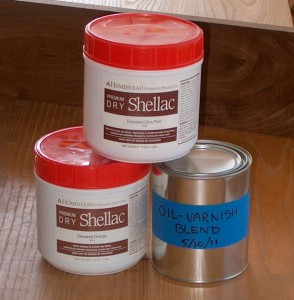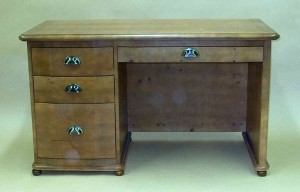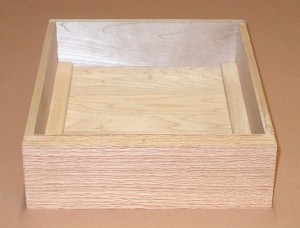 Many of today’s commercially sprayed finishes are very durable, but that comes with a price. Especially when built up into a thick film, those finishes are subject to chipping. And if color was applied within the spraying sequence (toning and glazing) those chips will be not only low spots but also lighter color spots, making them more noticeable.
Many of today’s commercially sprayed finishes are very durable, but that comes with a price. Especially when built up into a thick film, those finishes are subject to chipping. And if color was applied within the spraying sequence (toning and glazing) those chips will be not only low spots but also lighter color spots, making them more noticeable.
Invisible repairs are almost impossible, according to a long-time commercial finisher/refinisher. Stripping these modern sprayed finishes is difficult (i.e. expensive) because they are so hard. So the most common “solution” is to throw the chipped furniture away and buy new. But if the replacement has a similar finish . . .
Renewable finishes are an alternative.
Whether brushed, padded or sprayed, shellac is a film finish that builds on the surface of the wood. Shellac is widely considered one of the clearest finishes, so it allows to show through all the marvelous character and figure in wood. Today’s dewaxed shellac is more resistant to water marks than the shellac of the 1800′s and 1900′s. If the finish becomes worn in spots, in about a day, an experienced finisher can pad fresh shellac over the existing, and chips can be invisibly filled in with fresh shellac.
An oil-varnish blend is commonly equal parts varnish, boiled linseed oil and mineral spirits. The oil component wonderfully warms wood and sometimes gives an almost three dimensional appearance to curl and other figure. The first coat soaks into the wood, following coats add protection wthout building a noticeable film or shine. Three or four thin coats offer an unexpected level of resistance to water marks without eliminating the marvelous tactile sensation of wood surfaces. Unlike shellac, scratches into the wood cannot be filled up with a fresh application, but the exposed lighter wood will blend into the rest of the surface with another wiped coat. And like shellac, should the surface look a bit aged in areas of higher use another coat can be wiped on the piece to renew the finish.
Dewaxed shellac and oil-varnish can be applied with less waste,and there is less likelihood of having to strip a finish (with accompanying hazardous waste). These finishes should be treated with respect and common sense, but need not be feared. And with a renwable finish, furniture perhaps is more likely to kept for decades, developing a wonderful patina with associated family memories.


